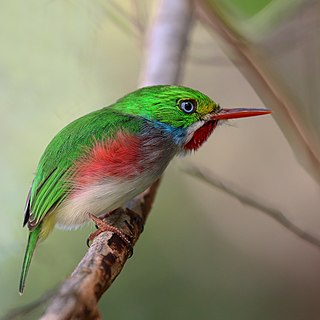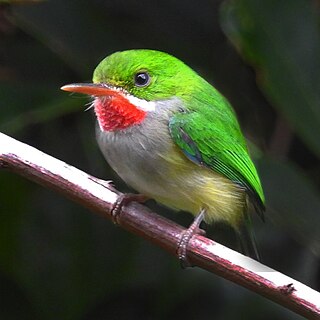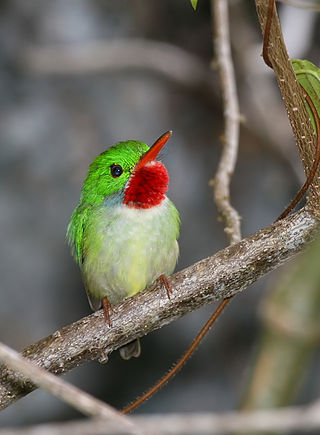Related Research Articles

ʻĪao Valley is a lush, stream-cut valley in West Maui, Hawaii, located 3.1 miles (5 km) west of Wailuku. Because of its natural environment and history, it has become a tourist location. It was designated a National Natural Landmark in 1972.

The todies are a family, Todidae, of tiny Caribbean birds in the order Coraciiformes, which also includes the kingfishers, bee-eaters and rollers. The family has one living genus, Todus, and one genus known from the fossil record, Palaeotodus.

Haleakalā, or the East Maui Volcano, is a massive shield volcano that forms more than 75% of the Hawaiian Island of Maui. The western 25% of the island is formed by another volcano, Mauna Kahalawai, also referred to as the West Maui Mountains.

Haleakalā National Park is an American national park located on the island of Maui in the state of Hawaii. Named after Haleakalā, a dormant volcano within its boundaries, the park covers an area of 33,265 acres, of which 24,719 acres is a wilderness area. The land was designated a national park in 1976 and its boundaries expanded in 2005.

Argyroxiphium sandwicense subsp. macrocephalum, the east Maui silversword or Haleakala silversword, is a rare plant, part of the family Asteraceae. The silversword in general is referred to as ʻāhinahina in Hawaiian.

The Puerto Rican tody is a bird endemic to Puerto Rico. It is locally known in Spanish as "San Pedrito" and "medio peso".

Puerto Rican migration to Hawaii began when Puerto Rico's sugar industry was devastated by two hurricanes in 1899. The devastation caused a worldwide shortage in sugar and a huge demand for the product from Hawaii. Consequently, Hawaiian sugarcane plantation owners began to recruit the jobless, but experienced, laborers in Puerto Rico.

Todus is a genus of birds in the family Todidae, the todies, found in the Caribbean. It is the only extant genus within the family Todidae. The five species are small, near passerine birds of the forests of the Greater Antilles: Puerto Rico, Jamaica, and Cuba, with adjacent islands, have one species each, and Hispaniola has two, the broad-billed tody in the lowlands and the narrow-billed tody in the highlands.

The Cuban tody is a bird species in the family Todidae that is restricted to Cuba and the adjacent islands.

The Jamaican tody is a species of bird in the genus Todus endemic to Jamaica. Local names for the Jamaican tody include rasta bird, robin and robin redbreast.

The poʻo-uli or black-faced honeycreeper, is an extinct species of passerine bird that was endemic to the island of Maui in Hawaiʻi. It is considered to be a member of the Hawaiian honeycreepers, and is the only member of its genus Melamprosops. It had a black head, brown upper parts and pale gray underparts. This bird inhabited only the wetter, easternmost side of Maui, where it had rapidly decreased in numbers. With extinction threatening, efforts were made to capture birds to enable them to breed in captivity. These efforts were unsuccessful; in 2004, only two known birds remained, and since then, no further birds have been sighted. A 2018 study recommended declaring the species extinct, citing bird population decline patterns and the lack of any confirmed sightings since 2004, and in 2019, the species was declared extinct.

The elfin woods warbler is a species of bird endemic to Puerto Rico, where it is local and uncommon. Discovered in 1968 and described in 1972, it is the most recently described New World warbler.

Adelaide's warbler is a bird endemic to the archipelago of Puerto Rico belonging to the genus Setophaga of the family Parulidae. The species is named after Adelaide Swift, daughter of Robert Swift, the person who captured the first specimen.
Coquí is the common name for several species of small frogs in the genus Eleutherodactylus native to Puerto Rico. They are onomatopoeically named for the very loud mating call which the males of two species, the common coqui and the upland coqui, make at night. The coquí is one of the most common frogs in Puerto Rico, with more than 16 different species found within its territory, including 13 in El Yunque National Forest. Other species of this genus can be found in the rest of the Caribbean and elsewhere in the Neotropics, in Central and South America. The coquí is an unofficial national symbol of Puerto Rico; there is a Puerto Rican expression that goes, “Soy de aquí, como el coquí”, which translates to “I’m from here, like the coquí."

Kealia Pond National Wildlife Refuge is a coastal salt marsh along the south-central coast of Maui, Hawaiʻi. The refuge is located between the towns of Kihei and Maalaea, on both sides of North Kihei Road, Route 31. The wetland is also a 691-acre (2.80 km2) bird sanctuary, home to 30 species of waterfowl, shorebirds, and migratory ducks, including the ʻaukuʻu and the endangered āeʻo and ʻalae keʻokeʻo. Kealia Pond was selected as a wildlife refuge in 1953, protecting an initial 300 acres (1.2 km2) of land. The refuge joined the National Wildlife Refuge System in 1992.

The Maui ʻalauahio, also known as the Maui Nui ʻalauahio or Maui creeper, is a species of Hawaiian honeycreeper. It is endemic to Maui Nui, Hawaii. The name Maui ʻalauahio is somewhat misleading because the species seems to have occurred on most, if not all, parts of the ancient Maui Nui, which includes the present day islands of Maui, Molokaʻi, Lānaʻi, and Kahoʻolawe. There are two subspecies: the Lānaʻi ʻalauahio, P. montana montana, which occurred on Lānaʻi (extinct); and P. montana newtoni which occurs on Maui. The common name refers to both groups.
Cambalache State Forest and Reserve is a nature reserve and one of the 20 state forests in the territory of Puerto Rico. The Cambalache State Forest is located in the municipalities of Arecibo and Barceloneta in northern Puerto Rico.

Saba banana, is a triploid hybrid (ABB) banana cultivar originating from the Philippines. It is primarily a cooking banana, though it can also be eaten raw. It is one of the most important banana varieties in Philippine cuisine. It is also sometimes known as the "cardaba banana", though the latter name is more correctly applied to the cardava, a very similar cultivar also classified within the saba subgroup.
References
- ↑ "A comparative study of todies (Aves, Todidae), with emphasis on the Puerto Rican tody, Todus mexicanus - Cornell University Library Catalog".
- ↑ "Dr. Angela K. Kepler | Pacific Biodiversity Information Forum" . Retrieved 24 May 2021.
- ↑ Kepler, C. B.; Parkes, K. C. (1972). "A new species of warbler (Parulidae) from Puerto Rico". The Auk. 89 (1): 1–18. doi: 10.2307/4084056 . JSTOR 4084056.
- ↑ Kia‘i Moku: Banana bunchy-top virus poses threat to plants in Hawaii, Lissa Fox, Maui News, February 13, 2011
- ↑ "Authors: Angela Kay Kepler". AllBookstores.com.